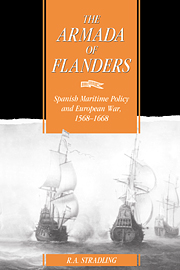Book contents
- Frontmatter
- Contents
- Preface
- Acknowledgements
- Glossary
- Rough comparative values of Spanish and Flanders currencies, c. 1620–60
- List of abbreviations
- Maps
- Part I Prologue – Failure and retrenchment, 1568–1621
- Part II The great offensive, 1621–1640
- Part III Dunkirk and the defence of Empire, 1640–1658
- Part 4 Quills, keels and cutlasses
- Epilogue Decay and transition, 1658–1668
- Appendices
- Bibliography
- Index
- Cambridge Studies in Early Modern History
Epilogue Decay and transition, 1658–1668
Published online by Cambridge University Press: 22 September 2009
- Frontmatter
- Contents
- Preface
- Acknowledgements
- Glossary
- Rough comparative values of Spanish and Flanders currencies, c. 1620–60
- List of abbreviations
- Maps
- Part I Prologue – Failure and retrenchment, 1568–1621
- Part II The great offensive, 1621–1640
- Part III Dunkirk and the defence of Empire, 1640–1658
- Part 4 Quills, keels and cutlasses
- Epilogue Decay and transition, 1658–1668
- Appendices
- Bibliography
- Index
- Cambridge Studies in Early Modern History
Summary
The fate of the town of Dunkirk appears to symbolise the retreat of Spain from positive influence in the maritime–continental history of western Europe. But as in other aspects of its withdrawal from hegemony, Spain went backwards fighting at every step. In 1658, Dunkirk passed into English hands, thus, exactly a century after the loss of Calais, restoring England's gateway to the continent. The expeditionary force provided the new garrison, and its general, Lockhart, assumed the governorship. After the Restoration, however, the place became an embarrassment for the Stuarts. Spain did not recognise English possession, and Caraqena placed it under quarantine from the landward side. There was violent friction between the occupying troops and the surrounding communities, technically subject to Dunkirk's fiscal privileges, and even between the soldieries of the opposed camps. English presence in Dunkirk helped to justify the clandestine privateering which continued from the other Flemish ports against her shipping – even though peace had been declared and licences officially revoked.
Lockhart's royalist successor, the Earl of Rutherford, commanded a force of veteran Cromwellian infantrymen, who thus continued to bear arms whilst their comrades at home were disbanded. In the precarious politics of the early Restoration period, its atmosphere heavy with (real and imagined) republican conspiracy, this was regarded as a hostage to fortune. The options were all unpromising. The cost of replacing the existing force with loyal troops was prohibitive, but whilst the New Modellers continued in arms there was always the chance of a mutiny.
- Type
- Chapter
- Information
- The Armada of FlandersSpanish Maritime Policy and European War, 1568–1668, pp. 229 - 238Publisher: Cambridge University PressPrint publication year: 1992



